ACT IV: PART I
We all know the inspiring story of Flight 93, of the heroic passengers who forced the hijacked plane to the ground, sacrificing themselves to save the lives of others. The only trouble is: it may simply not be true … The shortage of available facts did not prevent the creation of an instant legend – a legend that the US government and the US media were pleased to propagate, and that the American public have been eager, for the most part, to accept as fact. John Carlin “Unanswered Questions: The Mystery of Flight 93,” The Independent, August 13, 2002
Before the official spin set in and United Airlines Flight 93 became forever known as the “Let’s Roll” flight, immortalized in numerous articles, web postings, books and movies, early reports from local journalists on the scene strongly suggested a much different scenario than the one sold to the American people. So too does all the available photographic evidence. And the overwhelming majority of eyewitness accounts also paint a much different picture of the fate of Flight 93 than the story sold by Washington and its media cohorts.
That official story, of course, holds that a Boeing 757 that took off for San Francisco, California out of Newark, New Jersey at 8:42 AM, well past its scheduled liftoff time, was hijacked somewhere over Pennsylvania by four knife-wielding terrorists, all wearing red bandannas, with one sporting a fake bomb strapped around his waist. At about 9:35 AM, the aircraft abruptly turned around somewhere over the Cleveland area and began heading back towards Washington, presumably with the intention of impacting a target of strategic importance. From about 9:30 until just before 10:00 AM, as the aircraft headed east over Ohio and Pennsylvania, numerous passengers and crew members frantically placed calls to loved ones. During some of those calls, passengers learned of the attacks in New York and, quickly deducing what their likely fate would be, decided to attempt to overpower the hijackers and gain control of the aircraft. During the ensuing struggle, control of the plane was lost and it plummeted to the ground, plowing into abandoned coal-mining land near Shanksville, Pennsylvania at 10:06 AM, killing all forty-four people on board (seven crew members, four hijackers and thirty-three passengers).
Needless to say, Hollywood just loves the Flight 93 story, with its iconic images of the heroism and patriotism of ordinary Americans. And there quite likely was heroism exhibited aboard that aircraft that day. But perpetuating a lie does nothing to honor the memory of those who died on September 11, particularly if that lie is brazenly exploited by the very people responsible for the death and destruction that day. If we are to do more than just crassly exploit the dead, we first have to understand how they really died.
Despite the magnitude of the events of September 11, 2001, and despite the monumental changes in our lives that have occurred in the aftermath of those attacks, the vast majority of Americans have never bothered to look at any of the details of what happened that day. Having read the above one-paragraph summary of the saga of Flight 93, you, the reader, probably already know more about what supposedly happened in Shanksville that day than the average American. As a nation, we have accepted that our world must fundamentally change as a result of what happened that day, and yet we can’t be bothered with actually taking the time to look at what really did happen that day. We have accepted the notion that torture is now a legitimate tool of the state, and that anyone deemed an enemy of that state can be tried and convicted with ‘evidence’ that need never be revealed. In doing so, we have sacrificed not only our most basic rights, and not only the lives of our sons and daughters, but, most tragically of all, our very humanity, and we have done so on blind faith, never bothering to look at any evidence beyond the endlessly replayed images of crashing jets and collapsing towers.
To say that this is a pathetic state of affairs would be quite an understatement.
Most Americans probably assume that they saw footage of a crashed airplane in Pennsylvania sometime during the day of September 11, 2001, or shortly thereafter. We were, after all, provided with nonstop coverage of the attacks across the television dial for several weeks, so there was certainly ample time to air some footage of the smoldering wreckage of Flight 93, or at least some eyewitnesses describing the wreckage of Flight 93, or maybe a location interview with a rescue worker describing the harrowing task of recovering bodies. But though we may think that we saw such images amid the chaos of that day, we most certainly did not – just as we did not see any footage of aircraft wreckage at the Pentagon.
And we never will, for the simple reason that images such as those do not exist – and if someone were going to manufacture them using Hollywood wizardry, they would have already done so.
Don’t get me wrong here: images of the purported crash site of Flight 93 do exist. Some of those photographs and digital images were taken within minutes of the alleged event, long before any cleanup efforts began. Some of the photographs were even taken by the government’s own crash investigators. None of them, however, depict the site of the actual crash of a large passenger plane. We know this because, as a general rule of thumb, aircraft crash sites contain recognizable aircraft wreckage.
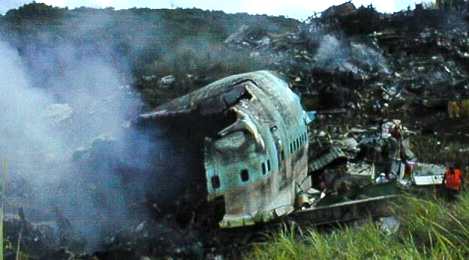
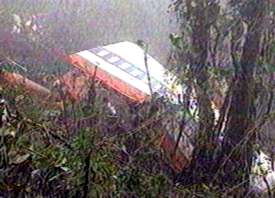

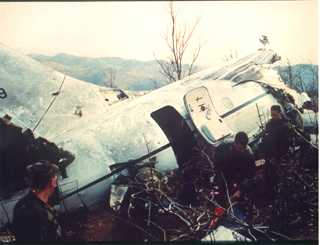
Just as one would expect to find some recognizable vehicle wreckage at the scene of even the most horrendous of car crashes, one likewise expects to find aircraft wreckage at the scene of a plane crash. Historically, at least, that is how these things have always worked, as can be seen in the above photos of various Boeing 7X7 aircraft that have crashed over the years. According to all early reports, however, there was no such wreckage to be seen anywhere near the alleged crash site of Flight 93.
An early report from the Pittsburgh Post-Gazette, for example, contained several eyewitness accounts, all of which noted a curious lack of recognizable aircraft debris. Co-workers Homer Barron and Jeff Phillips, for example, “drove to the crash scene and found a smoky hole in the ground … ‘It didn’t look like a plane crash because there was nothing that looked like a plane,’ Barron said. ‘There was one part of a seat burning up there,’ Phillips said. ‘That was something you could recognize.’ ‘I never seen anything like it,’ Barron said. ‘Just a big pile of charcoal.'” (“The Crash in Somerset: ‘It Dropped Out of the Clouds,'” Pittsburgh Post-Gazette, September 12, 2001)
Nina Lensbouer, identified as a former volunteer firefighter, told reporters that her “instinct was to run toward it, to try to help. But I got there and there was nothing, nothing there but charcoal. Instantly, it was charcoal.” Similarly, “Charles Sturtz, 53, who lives just over the hillside from the crash site, said a fireball 200 feet high shot up over the hill. He got to the crash scene even before the firefighters. ‘The biggest pieces you could find were probably four feet [long]. Most of the pieces you could put into a shopping bag.” (“The Crash in Somerset: ‘It Dropped Out of the Clouds,'” Pittsburgh Post-Gazette, September 12, 2001)
Mark Stahl, digital camera in hand, was one of the first witnesses on the scene, just minutes after the alleged crash. He had an unobstructed view of the crater and surrounding area, which he took the time to photograph. Nevertheless, he had no clue that he was photographing the site of a purported plane crash: “He didn’t realize a passenger jet had crashed until a firefighter told him.” Ron Delano was another early arrival at the scene; “He was stunned by what he saw. ‘If they hadn’t told us a plane had wrecked, you wouldn’t have known.’” (“Homes, Neighbors Rattled by Crash,” Pittsburgh Tribune-Review, September 12, 2001)
Area resident Eric Peterson, according to the Post-Gazette, “rushed to the scene on an all-terrain vehicle and when he arrived he saw bits and pieces of an airliner spread over a large area of an abandoned strip-mine in Stonycreek Township. ‘There was a crater in the ground that was really burning,’ Peterson said. Strewn about were pieces of clothing hanging from trees and parts of the Boeing 757, but nothing bigger than a couple of feet long, he said. Many of the items were burning. Peterson said he saw no bodies, but there also was no sign of life.” (Jonathan D. Silver “Day of Terror: Outside Tiny Shanksville, a Fourth Deadly Stroke,” Pittsburgh Post-Gazette, September 12, 2001)
In a similar vein, a Reuters wire report held that the impact “was so powerful that police investigators who cordoned off the site as a crime scene on Tuesday reported finding no pieces of debris larger than a phone book, and no bodies.” (“Passengers on Flight 93 May Have Struggled With Hijackers,” Reuters, September 12, 2001)
Remarkably enough, the government’s own official photographs of the crime scene, introduced as evidence during the hopelessly tainted Zacarias Moussaoui trial earlier this year, confirm those early reports. The three aerial photographs below (which can be enlarged for a better look) reveal that not only was there no significant wreckage visible in the supposed impact crater, there was no significant wreckage visible anywhere near the crater!
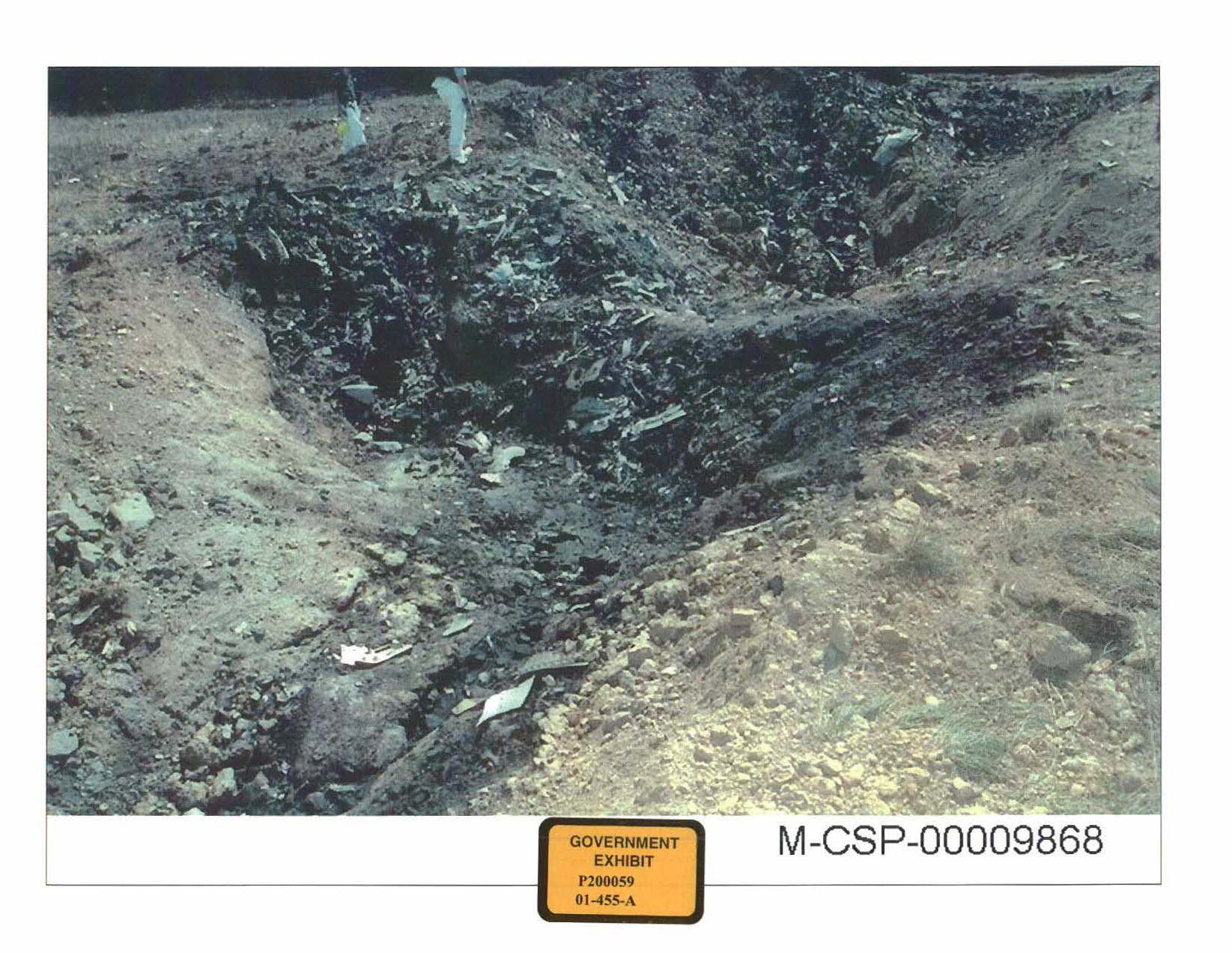
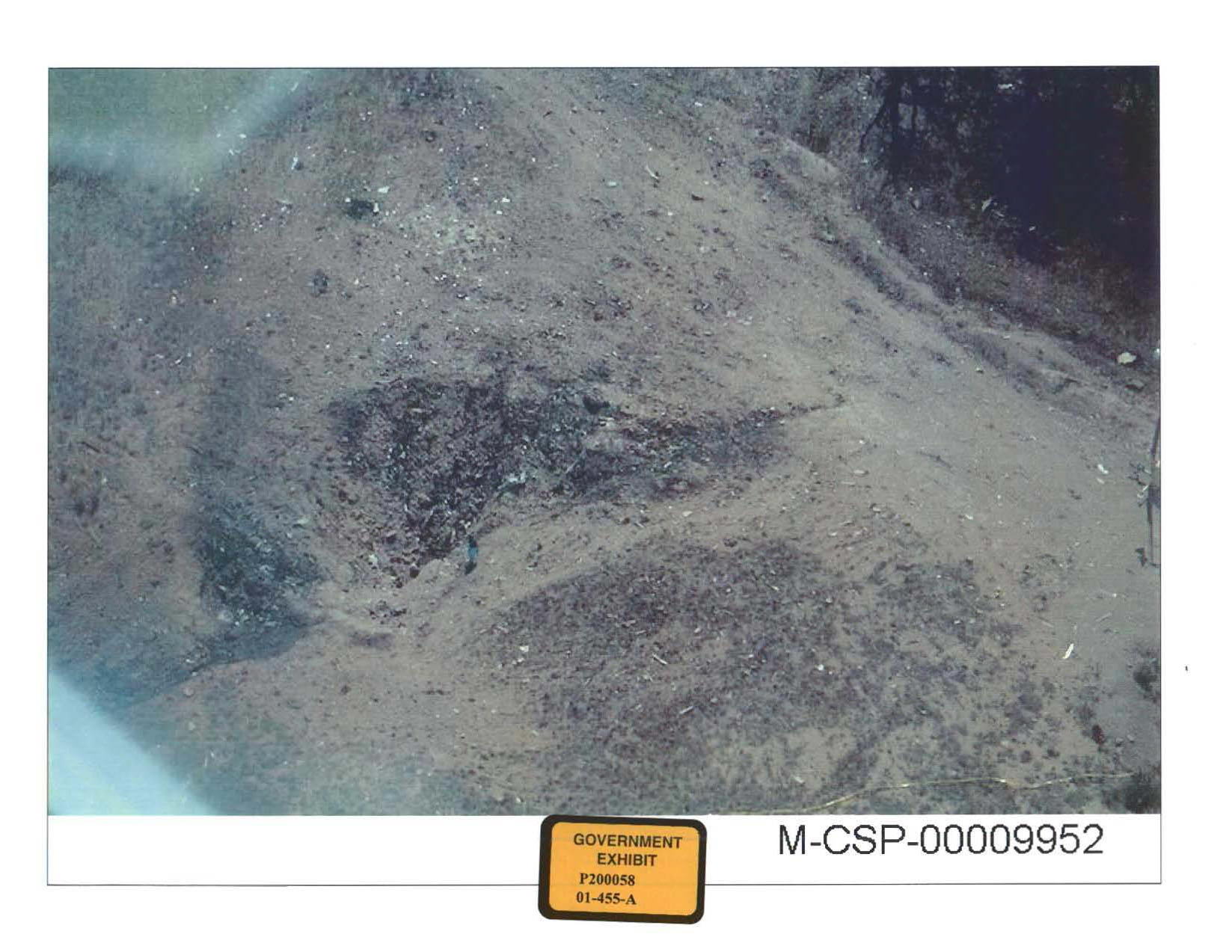
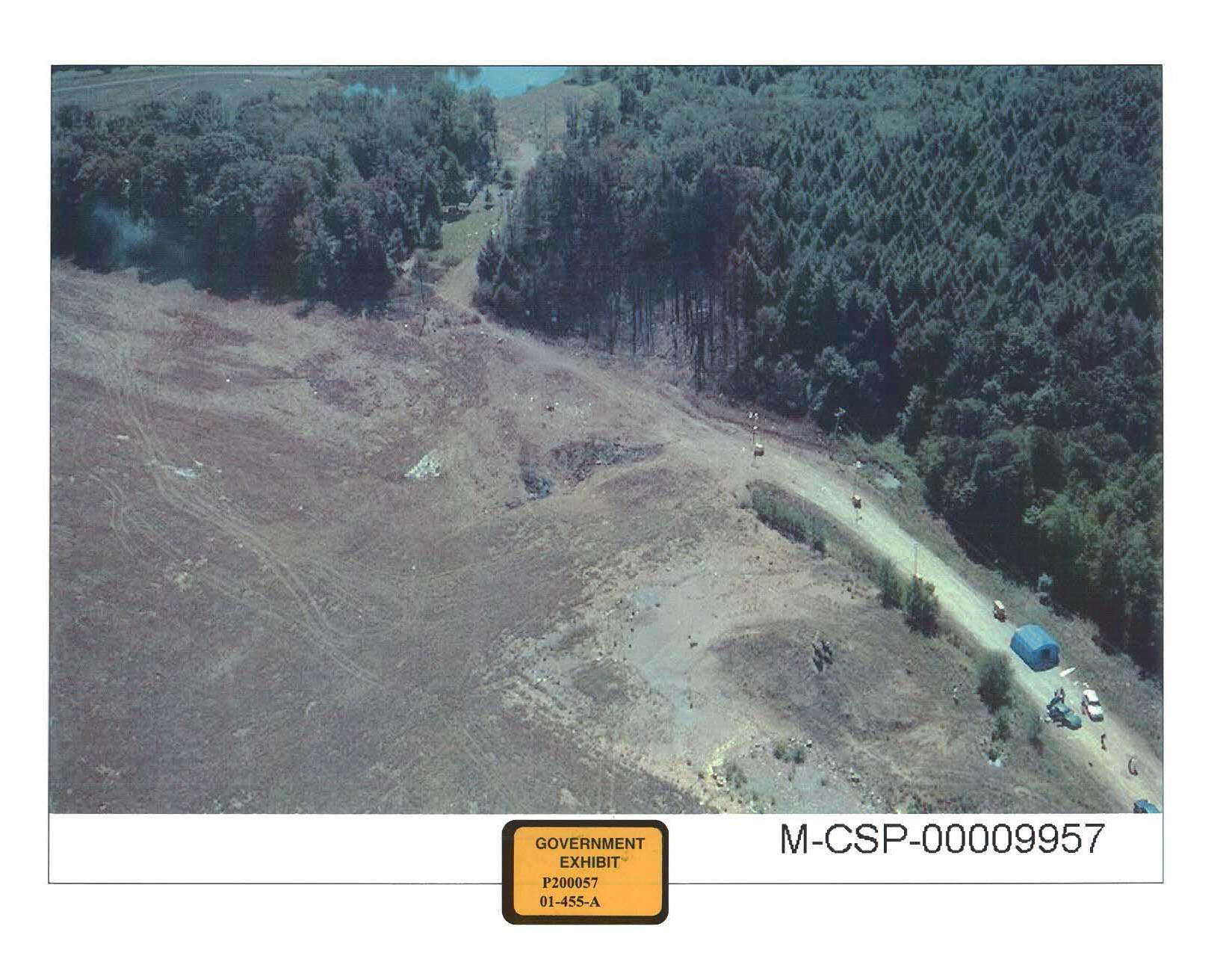
According to the official 9-11 narrative, the lack of visible wreckage is attributable to the fact that the plane is actually buried in the ground beneath the crater. Flight 93 impacted with such tremendous force, we are told, that virtually the entire aircraft burrowed into the soil. As we all know, September 11, 2001 was ‘the day that everything changed.’ Enormous office buildings, for example, suddenly and inexplicably acquired the ability to drop into their own footprints with no assistance from demolitions experts. Five-story masonry buildings suddenly acquired the extraordinary ability to swallow enormous airliners without leaving behind an appropriate entry hole or any trace of aircraft wreckage. And now we find, perhaps most amazingly of all, that the ground itself somehow also acquired the ability to swallow commercial aircraft. On that fateful day, and only on that day, a 100+ ton airplane measuring 155 feet long, 125 feet wide and 45 feet tall disappeared into a crater measuring, at most, “about 30 to 40 feet long, 15 to 20 feet wide and 18 feet deep.” (“Crews Begin Investigation Into Somerset County 757 Crash,” ThePittsburghChannel.com, September 11, 2001)
Any skilled magician, I suppose, could make an airplane disappear into a building. But making an entire airplane disappear without a trace in an empty field? I have to admit that that is pretty impressive.
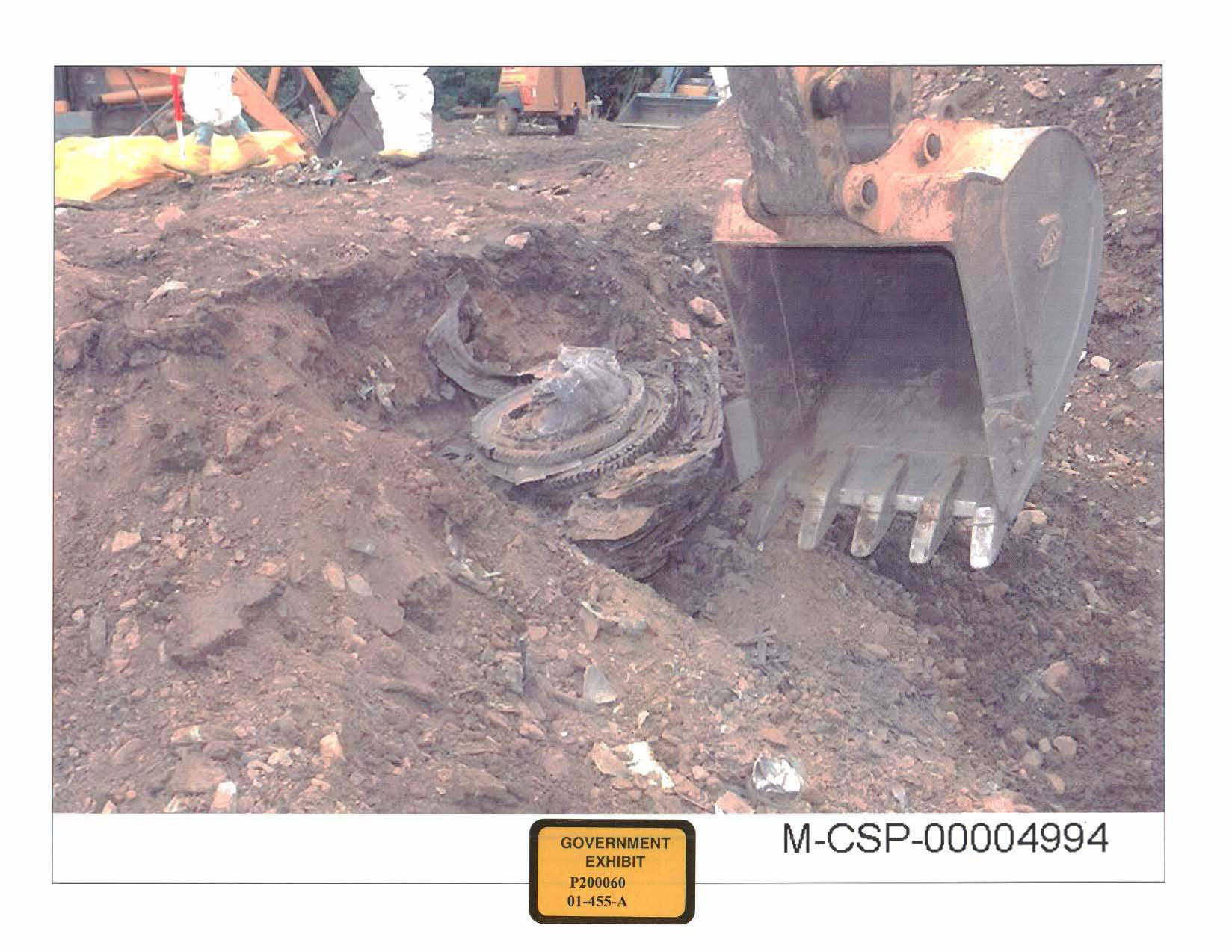
The patch of soil that purportedly swallowed United Airlines Flight 93 seems to have had some peculiar physical properties. The photo to the left purports to show one of the aircraft’s engines being excavated from the alleged impact crater (other parts were allegedly dug out of the ridiculously small hole as well, including the flight recorder, which reportedly burrowed to a depth of about twenty-five feet). Curiously though, several published reports noted that a “section of engine weighing a ton was located 2,000 yards – over a mile – from the crash site.” (Richard Wallace “What Did Happen to Flight 93?” Daily Mirror, September 12, 2002; some reports place the engine section at about a third that distance from the ‘crash’ site, or vaguely specify that it was found a “considerable distance” from the alleged impact crater.)
So what appears to have happened in Shanksville, as best I can determine, is that Flight 93 impacted what MSNBC referred to as “the loose, porous soil of a deserted strip mine” in such a way that the engine on one side of the aircraft burrowed deeply into the ground, while the engine on the other side of the plane, encountering the very same loose soil at the exact same moment in time, snapped off and bounced thousands of feet away! If this had happened on any other day, it would obviously beg for a rational explanation. But since it happened on September 11, 2001, and since we have already established that the physical properties of the world were in a strange state of flux that day, no further explanation is necessary.
If a nose-diving plane did in fact impact relatively soft earth at some 580 miles per hour, as the Warren 9/11 Commission has claimed, then it is conceivable that a portion of the plane could have burrowed into the ground – but certainly not the entire 155-foot-long aircraft. A substantial portion of the plane would surely have been visible jutting out of the alleged impact crater. And if the entire aircraft did somehow plow into the ground, then wouldn’t the buried wreckage consist of a 100-ton compacted mass of metal, fabric and human tissue, rather than a few scattered bits and pieces of the airplane?
If you’re like me, you’re probably wondering right about now what exactly happened to the rest of the airplane. If none of it was visible outside the crater, and only a few pieces were allegedly exhumed from within the crater, then what became of the rest of the plane, along with all its passengers, luggage and cargo?
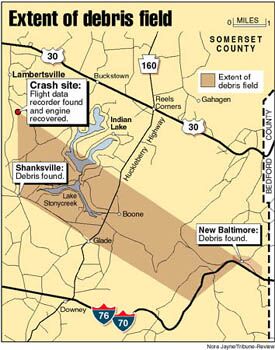
As it turns out, much of the wreckage was distributed, in tiny bits and pieces, over a debris field of roughly 15 square miles. As the Pittsburgh Post-Gazette reported, “United Airlines Flight 93, a Boeing 757-200 en route from New Jersey to San Francisco, fell from the sky near Shanksville at 10:06 a.m., about two hours after it took off, leaving a trail of debris five miles long.” That trail of debris, it turns out, was later found to extend more than eight miles. (Jonathan D. Silver “Day of Terror: Outside Tiny Shanksville, a Fourth Deadly Stroke,” Pittsburgh Post-Gazette, September 12, 2001)
Under normal circumstances, an airplane that nose-dives into the ground and burrows into the soil will not leave a miles-long trail of debris, though an airplane that blows apart in the air certainly will. Flight 93, of course, did not blow apart in the air, so the only explanation for the debris trail, once again, is the mysterious break in the time/space continuum that fateful day.
According to numerous published reports, debris from the aircraft was “found up to 8 miles from the crash site … Papers and other light objects were carried aloft by the explosion after impact of the plane and they were transported by a nine-knot wind.” (Bill Heltzel and Tom Gibb “2 Planes Had No Part in Crash of Flight 93,” Pittsburgh Post-Gazette, September 16, 2001) According to my crude calculations, that means that debris allegedly ejected from the plane when it impacted the ground somehow remained aloft for nearly a full hour as it drifted for miles across the local terrain. And this was not, it should be noted, relatively flat terrain that the debris allegedly drifted over. To the contrary, for the detritus to travel the length of the debris field, from the alleged crash site to the town of New Baltimore, it would have had to pass – are you ready for this? – up and over a mountain ridge! “Authorities,” understandably enough, “initially insisted crash debris could not have traveled over a mountain ridge more than eight miles from the crash.” Those same authorities, however, later came to their senses and insisted that such a scenario was “not only plausible, but probable.” (Debra Erdly “Crash Debris Found 8 Miles Away,” Pittsburgh Tribune-Review, September 14, 2001)
Much of the debris seems to have landed on the Indian Lake area, roughly two to three miles from the purported ‘crash’ site. And this was not isolated bits and pieces of debris; what “workers at Indian Lake Marina said they saw [was] a cloud of confetti-like debris descend on the lake and nearby farms.” (Tom Gibb, James O’Toole and Cindi Lash “Investigators Locate ‘Black Box’ From Flight 93; Widen Search Area in Somerset Crash,” Pittsburgh Post-Gazette, September 13, 2001) Witness Carol Delasko also spoke of what “looked like confetti raining down all over the air above the lake.” (Debra Erdly “Crash Debris Found 8 Miles Away,” Pittsburgh Tribune-Review, September 13, 2001)
These witness accounts would seem to indicate that there had been some kind of explosive event in the air above Indian Lake, rather than on the ground a couple miles away. At least one early report quoted witnesses who claimed that an airplane had literally broken apart in the air over the Indian Lake area: “investigators also are combing a second crime scene in nearby Indian Lake, where residents reported hearing the doomed jetliner flying over at a low altitude before ‘falling apart on their homes.’ ‘People were calling in and reporting pieces of plane falling,’ a state trooper said. Jim Stop reported he had seen the hijacked Boeing 757 fly over him as he was fishing. He said he could see parts falling from the plane.” (Robin Acton and Richard Gazarik “Human Remains Recovered in Somerset,” Pittsburgh Tribune-Review, September 13, 2001)
The ‘gopher plane’ theory, alas, provides no explanation for these reports and witness accounts. How is it possible, after all, for an airplane to hit the ground intact and burrow underground, and yet simultaneously break up into thousands of pieces that come to rest up to eight miles away, on the other side of a mountain ridge? And while we ponder that question, here is another one that begs for an answer: what became of the aircraft’s considerable load of aviation fuel (given that Flight 93 was fueled for a cross-country flight)?
Some of that fuel purportedly burned up in a fireball that arose from the crash site, but if the plane did in fact burrow into the ground, then logic dictates that a substantial amount of the fuel load would have been injected into the loose soil. The reality, however, is that no trace of jet fuel was found in any of the soil excavated from the crater and the surrounding area: “By today, Environmental Resources Management Inc. of Pine, a contractor hired by United, expects to return 5,000 to 6,000 cubic yards of soil to the 50-foot hole dug around the crater left by the crash. The soil is being tested for jet fuel, and at least three test wells have been sunk to monitor groundwater, since three nearby homes are served by wells, Betsy Mallison, a state Department of Environmental Protection spokeswoman, said. So far, no contamination has been discovered, she said.” (Tom Gibb “Latest Somerset Crash Site Findings May Yield Added IDs,” Pittsburgh Post-Gazette, October 3, 2001)
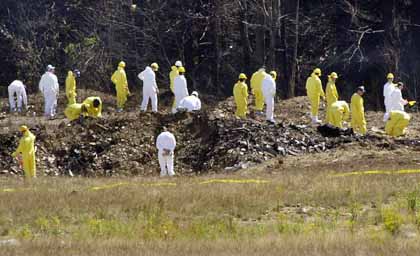
Also missing from the crater was any sign of the forty-four humans reportedly on board the plane. You would think that, at the very least, the remains of the flight crew and/or hijackers, who would have been in the nose of the aircraft when it plowed into the ground, would have ended up at the bottom of the Shanksville crater. But there is no indication from any local or national reports that any human remains were exhumed from that crater. As the Washington Post reported, “Immediately after the crash, the seeming absence of human remains led the mind of coroner Wally Miller to a surreal fantasy: that Flight 93 had somehow stopped in mid-flight and discharged all of its passengers before crashing. ‘There was just nothing visible,’ he says. ‘It was the strangest feeling.’ It would be nearly an hour before Miller came upon his first trace of a body part.” (Peter Perl “Hallowed Ground,” Washington Post, May 12, 2002)
Perhaps when the plane stopped to discharge its passengers, it also jettisoned its load of fuel.
Despite extensive recovery efforts, nothing resembling a human corpse was ever found, officially at least, anywhere within the eight-mile-long debris field. According to the official storyline, all that was recovered, “apart from, here and there, a finger, a toe or a tooth … were small pieces of tissue and bone.” (John Carlin “Unanswered Questions: The Mystery of Flight 93,” The Independent, August 13, 2002) The largest piece of human tissue reportedly found was “a section of spine eight inches long.” (Richard Wallace “What Did Happen to Flight 93?” Daily Mirror, September 12, 2002) No torsos, no arms, no legs, no hands, no feet – not even a head, or at least a portion of one of the forty-four skulls.
To briefly recap then, what we have learned thus far is that United Airlines Flight 93, as per the official narrative, nose-dived into some former strip-mining land in rural Pennsylvania. Encountering loosely packed soil, the entire aircraft, or at least a significant portion of it, slipped rather effortlessly into the ground. A small portion of the aircraft, however – the portion containing all the passengers and flight crew, and all the luggage, and all the cargo, and all the fuel, and the vast majority of the airplane itself – exploded on the ground and was reduced to scraps that soared over mountaintops to reach destinations up to eight miles away.
Such a scenario, while laughably absurd, is no harder to believe than most of the other claims that we have been fed concerning the events of September 11, so there is little reason to suspect that we have been lied to about the fate of Flight 93. But just to be sure, we should probably look a little deeper into the ‘crash’ of Flight 93.


Trackbacks/Pingbacks